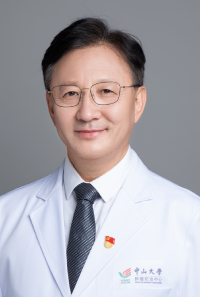- Name: Zhang Fujun
- Title: Professor and Chief Physician
- Email: zhangfj@sysucc.org.cn
- Phone:
1987: Graduated from undergraduate medical program at Inner Mongolia Medical University.
1997: Obtained a master’s degree in medical imaging and nuclear medicine from Norman Bethune College of Medicine Jilin University.
2006: Obtained a doctoral degree in medical imaging and nuclear medicine from Second Military Medical University
09/2008-12/2008: Acted as a visiting scholar in the Department of Radiology, U.S. Baylor College of Medicine
1.Osteosarcoma:Limb salvaging treatment by ultrasonogrphically guided high intensity focused ultrasound.CancerBiolTher 2009;(12)1102-1108
2.Superficial malignant tumors:Non-invasive treatment with ultrasonographically guided high-Intensity focused ultrasound.CancerBiolTher 2009;8(24)(December15;2009)
3.Short to mid term evaluation of CT-guided I125 brachytherapy on intra-hepatic recurrent tumors and/or extra-hepatic metastases after liver transplantation for hepatocellular carcinoma.CancerBiol Ther.2009;8(7):585-590
4. Feasibility of 125I brachytherapy combined with sorafenib treatment in patients with multiple lung metastases after liver transplantation for hepatocellular carcinoma. Journal of Cancer Research and Clinical Oncology. 2010 Nov;136(11):1633-40
5. Noninvasive treatment of malignant bone tumors using high-intensity focused ultrasound.Cancer. 2010 Aug 15;116(16):3934-42.
6. Therapeutic effects and prognostic factors in high-intensity focused ultrasound combined with chemoembolisation for larger hepatocellular carcinoma. European Journal Cancer. 2010 Sep;46(13):2513-21
7. Microwave ablation treatment of liver cancer with 2,450-MHz cooled-shaft antenna: an experimental and clinical study.Journal of Cancer Research and Clinical Oncology. 2010 Oct;136(10):1507-16
8. An imageable retinoid acid derivative to detect human cancer xenografts and study therapeutic dosing to reduce its toxicity.Contrast Media Mol Imaging. 2010 Nov 30. [Epub ahead of print]
9. Computed tomography and magnetic resonance imaging findings of peripheral primitive neuroectodermal tumors of the head and neck. European Journal of Radiology. 2011 Feb [Epub ahead of print]
10. Ke, S. and F. Zhang, et al. (2012). "Multiple target-specific molecular imaging agents detect liver cancer in a preclinical model." CurrMol Med 12 (8): 944-51.
11.Hu, X. and H. Qiu, et al. (2012). "Recurrent gliomas: comparison of computed tomography (CT)-guided 125I seed implantation therapy and traditional radiochemotherapy." Cancer BiolTher 13 (10): 840-7.
12. Peng, S. and Q. X. Yang, et al. (2014). "Lobaplatin-TACE combined with radioactive 125I seed implantation for treatment of primary hepatocellular carcinoma." Asian Pac J Cancer Prev 15 (13): 5155-60.
13. Yang, G. and S. Zhang, et al. (2014). "Osteopontin enhances the expression of HOTAIR in cancer cells via IRF1." Biochim Biophys Acta 1839 (9): 837-48.
14. Yang, G. and S. Zhang, et al. (2014). "The inhibitory effects of extracellular ATP on the growth of nasopharyngeal carcinoma cells via P2Y2 receptor and osteopontin." J Exp Clin Cancer Res 33: 53.
15. Zhang, T. and M. Lu, et al. (2014). "CT-guided implantation of radioactive 125I seed in advanced non-small-cell lung cancer after failure of first-line chemotherapy." J Cancer Res Clin Oncol 140 (8): 1383-90.
16. Yang, G. and S. Peng, et al. (2014). "Cell-based assay system to estimate the effect of 125I seeds on cancer cells: effect of osteopontin." Recent Pat Anticancer Drug Discov 9 (2): 258-63.
17. Zhang, W. and Y. Zhang, et al. (2014). "Multi-modality imaging to determine the cellular heterogeneity of nasopharyngeal carcinoma components." Oncotarget 5 (8): 2221-9.
18. Liu, Z. and F. Gao, et al. (2014). "Combination of radiofrequency ablation with transarterial chemoembolization for hepatocellular carcinoma: an up-to-date meta-analysis." Tumour Biol.
Updated by International Office, Sun Yat-sen University Cancer Center

